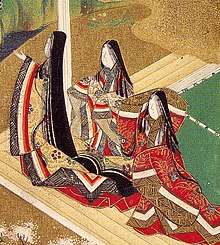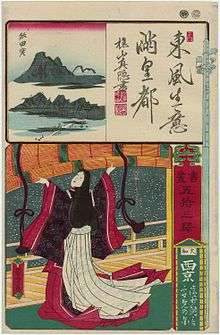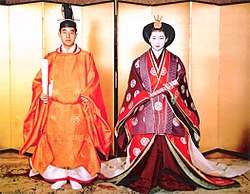Jūnihitoe
The jūnihitoe (十二単) - lit. "twelve layers" - is a style of formal court dress first worn in the Heian period by noble women and ladies-in-waiting at the Japanese Imperial Court. The jūnihitoe, despite the name, varies in its exact number of layers,[1] and is composed of several different kimono-style garments.

The jūnihitoe first appeared some time around the 10th century; however, by the Kamakura period, the number of layers worn by artistocratic ladies, even in court, had been reduced heavily. In the present day, the jūnihitoe is still worn by members of the Imperial House of Japan on important occasions.
Components, colours, and accessories


The layers of jūnihitoe
The term jūnihitoe is the common name rather than the formal name for the set of clothing and accouterments that are worn together.[2] The various layers are silk garments. The innermost garment is made of white silk, followed by other layers, which are finally closed off by a final layer or coat. There were many more layers in the early forms of jūnihitoe, and the total weight of the layers of clothings could add up to 20 kilograms. Due to its weight, movement in such a robe can be difficult. Heian ladies sometimes slept in their jūnihitoe, using it as a form of pajamas. Layers could be shed or kept, depending on the season and the night temperatures. By the Muromachi-Era, however, the number of layers of the dress was reduced.
The layers of clothing may be known by separate names, such as hitoe (unlined robe), itsutsuginu (五衣) which is a series of robes (usually 5 and of different colours),[3] a short coat karaginu (唐衣), and mo (裳). The last three terms can be combined to give the formal name for the jūnihitoe set of clothing – itsutsuginu-karaginu-mo (五衣唐衣裳).[4] The layers of the jūnihitoe consist of:[5]
- The undergarments: Usually a two-piece cotton or silk garment.
- Kosode: A short silk red or white robe of ankle or lower calf length.
- Nagabakama: The formal version of hakama worn by noble women; it is a very long red pleated split skirt.
- Hitoe: An unlined silk robe; usually red, white or blue-green, although other colors (such as dark red-violet or dark green) very rarely occur.
- itsutsuginu: A series of brightly coloured robes or uchigi, usually 5 or sometimes 6, which create a layered effect. Many more layers of uchigi were worn during the Heian period until the government enacted sumptuary laws reducing the number of layers worn.[5][6]
- Uchiginu: A beaten scarlet silk robe worn as a stiffener and support for the outer robes.
- Uwagi: A patterned woven and decorated silk robe than is shorter and narrower than the Uchiginu. The colour and fabric used for the uwagi indicate the rank of the wearer.
- Karaginu: A waist length Chinese style jacket.
- "Mo": An apron-like train, down the back of the robe. White with painted or embroidered adornment.

On less formal occasions, kouchigi (lit., "small cloak"), a shorter brocade robe may be worn over the uchigi or uwagi to add some formality on occasions when the karaginu and mo are not worn.[7][8] However, karaginu and mo must be worn for the jūnihitoe to be considered the formal attire of the most noble women.[9]
Colours and arrangements
The colours and the arrangements of the layers have particular significance in jūnihitoe. The only place where the layers are discernible is around the sleeves, hems and the neck. During the Heian period, a woman may be sat hidden behind a sudare screen with only the lower part of the body and sleeve edges visible to an outsider. The layers of colours may be used to represent the woman herself, and the arrangements of the layers and their colours were a good indication to an outsider what taste and what rank the lady had. The colour combinations, termed kasane no irome (襲の色目, "layers of colours"),[6] may have poetic names that refer to plants, such as "crimson plum of the spring". A name "under the snow" may have a layer of green representing leaves, layers of pink, with white on top to represent snow. The colour combinations changed with the seasons, and a wearer may change the gowns just before the flowers of a seasonal plant actually bloom. The appropriate use of colour gave an indication of the cultured and refined taste of the wearer.[10]
Apart from their robes, Japanese court ladies of the Heian era also wore their hair very long, only cut at the sides of their faces in a layered fashion; the longer hair was sometimes worn tied back. The hair arrangement is referred to as suberakashi (垂髪), and an ornament may be worn on the forehead.
Accessories
An important accessory is an elaborate fan, which could be tied together by a rope when folded. This was used by the lady not only to cool herself, since it could get very hot, but it was also an important communication device. Since a lady was not allowed to speak face-to-face to a male outsider, she could hold her sleeve up or use her opened fan to shield herself from inquiring looks. Communication to a suitor had to follow with her normally hiding behind the sudare (screen or blinds) in any case. The suitor could only see the sleeves of her jūnihitoe that were peeking underneath the blinds. This practice was prominent during the Heian-Era as described in the Tale of Genji.
Contemporary use

Today, the jūnihitoe can only normally be seen in museums, movies, costume demonstrations, tourist attractions or at certain festivals. These robes are one of the most expensive items of Japanese clothing. Only the Imperial Household still officially uses them at some important functions. Women such as an empress or princess wear a jūnihitoe, while men such as the Emperor or a prince wear a sokutai. During the wedding of Empress Masako to the crown prince, she wore a jūnihitoe for the official ceremony. The jūnihitoe was also worn by Empress Michiko during the enthronement ceremony of Emperor Akihito in 1990. Her ladies-in-waiting were all wearing the jūnihitoe; however, in modified form from the Edo period, not the Heian style.
The Saiō Matsuri Saiō Festival is held every in Meiwa, Mie and showcases Heian era dresses. They are also featured at the Aoi Matsuri in Kyoto.
References
- Tomoyuki Yamanobe (1957). Textiles. p. 49.
- Takie Sugiyama Lebra (29 January 1993). Above the Clouds: Status Culture of the Modern Japanese Nobility. University of California Press. p. 378. ISBN 9780520911796.
- "Fabric Details".
- "What is Jyuni- Hitoe?". Japanese Kimono.
- Harvey, Sara M. "The Juni-hito of Heian Japan". Archived from the original on 16 July 2011.
- "Kasane No Irome - Introduction".
- "Court lady in semiformal costumes known as "itsutsu-ginu kouchiki"". The Costume Museum.
- "Examples of Jūnihitoe, Kasane no iro, from the Costume Museum in Kyoto". The Costume Museum.
- Shaver, Ruth M. Kabuki Costume.
- Cliffe, Sheila (23 March 2017). The Social Life of Kimono: Japanese Fashion Past and Present. Bloomsbury Academic. pp. 14–17. ISBN 978-1472585530.
Notes
- There is a Japanese band of the same name (see 12. Hitoe).
External links
| Wikimedia Commons has media related to Jūnihitoe. |
- Images of a jūnihitoe
- Gallery of Junihitoe Images
- Reference Chart of Juunihitoe Color Schemes (note: incomplete with some translation errors, but includes uwagi and karaginu colors)
- Reference Chart of Juunihitoe Color Schemes (note: complete, but written in Japanese characters and without uwagi/karaginu color information)
- How a Juunihitoe is Donned (thumbnail list links)
- Glossary